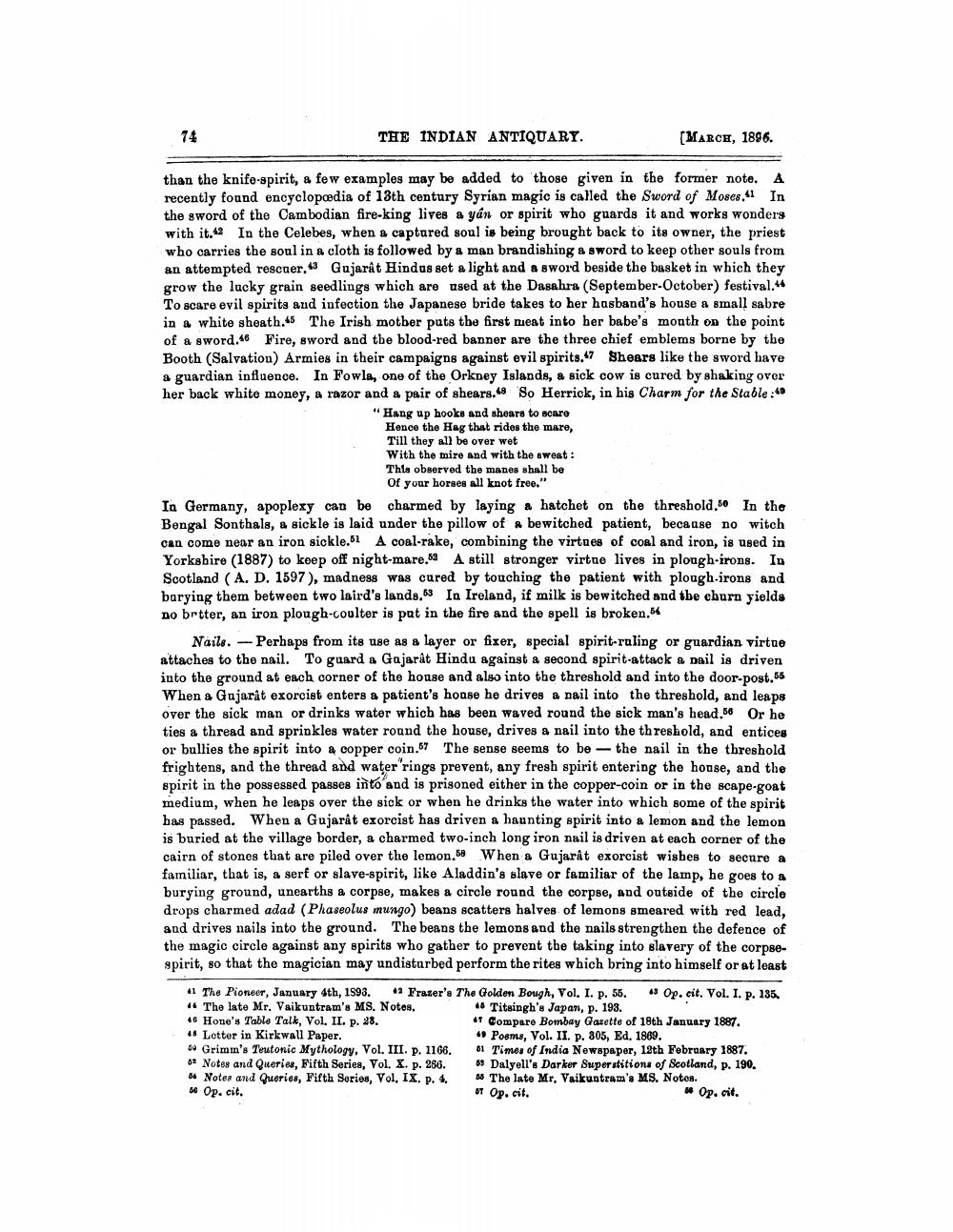________________
THE INDIAN ANTIQUARY.
than the knife-spirit, a few examples may be added to those given in the former note. A recently found encyclopedia of 13th century Syrian magic is called the Sword of Moses.41 In the sword of the Cambodian fire-king lives a yan or spirit who guards it and works wonders with it.42 In the Celebes, when a captured soul is being brought back to its owner, the priest who carries the soul in a cloth is followed by a man brandishing a sword to keep other souls from an attempted rescuer, 3 Gujarat Hindus set a light and a sword beside the basket in which they grow the lucky grain seedlings which are used at the Dasahra (September-October) festival. To scare evil spirits and infection the Japanese bride takes to her husband's house a small sabre in a white sheath.45 The Irish mother puts the first meat into her babe's mouth on the point of a sword.46 Fire, sword and the blood-red banner are the three chief emblems borne by the Booth (Salvation) Armies in their campaigns against evil spirits.47 Shears like the sword have a guardian influence. In Fowla, one of the Orkney Islands, a sick cow is cured by shaking over her back white money, a razor and a pair of shears.48 So Herrick, in his Charm for the Stable:
74
"Hang up hooks and shears to scare
Hence the Hag that rides the mare, Till they all be over wet
With the mire and with the sweat: This observed the manes shall be Of your horses all knot free."
In Germany, apoplexy can be charmed by laying a hatchet on the threshold.50 In the Bengal Sonthals, a sickle is laid under the pillow of a bewitched patient, because no witch can come near an iron sickle.51 A coal-rake, combining the virtues of coal and iron, is used in Yorkshire (1887) to keep off night-mare.52 A still stronger virtue lives in plough-irons. In Scotland (A. D. 1597), madness was cured by touching the patient with plough-irons and barying them between two laird's lands.53 In Ireland, if milk is bewitched and the churn yields no better, an iron plough-coulter is put in the fire and the spell is broken.54
[MARCH, 1896.
Nails. Perhaps from its use as a layer or fixer, special spirit-ruling or guardian virtue attaches to the nail. To guard a Gajarât Hindu against a second spirit-attack a nail is driven into the ground at each corner of the house and also into the threshold and into the door-post.55 When a Gujarât exorcist enters a patient's house he drives a nail into the threshold, and leaps over the sick man or drinks water which has been waved round the sick man's head.56 Or he ties a thread and sprinkles water round the house, drives a nail into the threshold, and entices or bullies the spirit into a copper coin.57 The sense seems to be the nail in the threshold frightens, and the thread and water rings prevent, any fresh spirit entering the house, and the spirit in the possessed passes into and is prisoned either in the copper-coin or in the scape-goat medium, when he leaps over the sick or when he drinks the water into which some of the spirit has passed. When a Gujarât exorcist has driven a haunting spirit into a lemon and the lemon is buried at the village border, a charmed two-inch long iron nail is driven at each corner of the cairn of stones that are piled over the lemon.58 When a Gujarât exorcist wishes to secure a familiar, that is, a serf or slave-spirit, like Aladdin's slave or familiar of the lamp, he goes to a burying ground, unearths a corpse, makes a circle round the corpse, and outside of the circle drops charmed adad (Phaseolus mungo) beans scatters halves of lemons smeared with red lead, and drives nails into the ground. The beans the lemons and the nails strengthen the defence of the magic circle against any spirits who gather to prevent the taking into slavery of the corpsespirit, so that the magician may undisturbed perform the rites which bring into himself or at least
41 The Pioneer, January 4th, 1993.
The late Mr. Vaikuntram's MS. Notes.
46 Hone's Table Talk, Vol. II. p. 28. 48 Lotter in Kirkwall Paper.
42 Frazer's The Golden Bough, Vol. I. p. 55. 43 Op. cit. Vol. I. p. 135,
45 Titsingh's Japan, p. 193.
41 Compare Bombay Gazette of 18th January 1887. 49 Poems, Vol. II. p. 305, Ed. 1869.
01 Times of India Newspaper, 12th February 1887. 53 Dalyell's Darker Superstitions of Scotland, p. 190. 55 The late Mr. Vaikuntram's MS. Notes. 01 Op. cit.
Op. cit.
Grimm's Teutonic Mythology, Vol. III. p. 1166. 52 Notes and Queries, Fifth Series, Vol. X. p. 266.
5 Notes and Queries, Fifth Series, Vol. IX. p. 4. se Op. cit.




